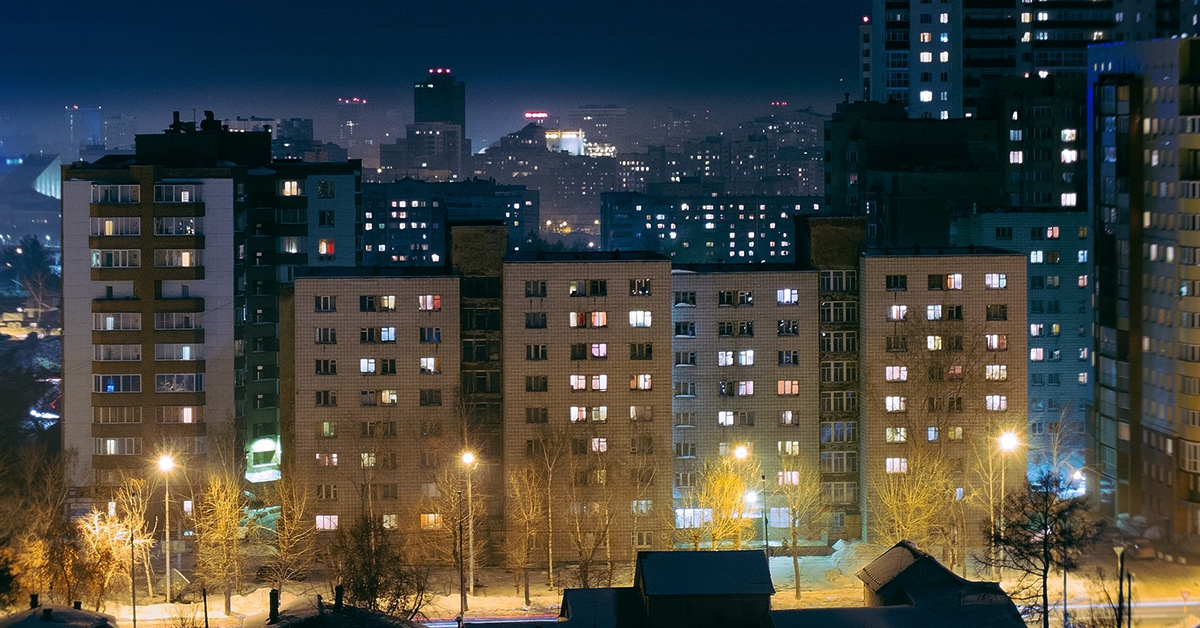
5 Common Issues Contributing to Premises Liability in Apartment Communities
When it comes to reducing premises liability in apartment communities and multi-family housing, an old adage provides best advice:
“An ounce of prevention is worth a pound of cure.”
Yet despite this wisdom, many in the apartment industry remain persistent targets of lawsuits with reliance on insurance and legal strategy as the main defense against premise liability.
Although these types of “consequence management measures” are a universal element of managing risk, we have witnessed numerous situations over the past few years where even the best legal defense did little to protect against multi-million dollar verdicts.
A Structured Approach to Reducing Premises Liability Risk in Apartment Communities and Multi-Family Housing
A more evolved strategy for reducing liability risk implements a structured approach to security and safety aimed at preventing lawsuits and establishing conditions that limit vulnerability in the courtroom. In addition to reducing liability, effective security can improve the quality of life for residents by reducing crime and improving the residents’ perception of safety. This has the added benefit of reducing resident turnover and increasing property values by reducing vandalism.
5 Common Security Negligence Issues Contributing to Premises Liability in Apartment Communities and Multi-Family Housing
As a security consultant, I work exclusively in aiding property owners and managers in reducing liability through effective security and safety. I do this by assessing properties for conditions of concern and presenting recommendations for security and environmental improvement and management practices which reduce crime and positively influence human behavior and resident perceptions.
Although every property I work with is unique, certain problems seem to be recurring themes during my assessment activities. For purposes of this article, I’ll narrow our focus to the five most common issues contributing to criminal confidence and social and physical disorder within residential properties.
1. Lighting
Illumination
Ensuring that properties are well-illuminated is one of the most basic principles of natural surveillance in Crime Prevention Through Environmental Design (CPTED). A well-illuminated property:
- Deters criminal activity by increasing the likelihood of a criminal being witnessed in the act.
- Additionally, effective CCTV imaging requires adequate illumination to ensure proper documentation of persons and activity.
- And beyond crime prevention, lighting is an important function of environmental safety and reduces the risk of nighttime accidents on property.
However, despite the importance of lighting and its potential influence on premise liability, this is a common issue in many of our property assessments.
To ensure lighting meets essential standards, it is recommended that a lighting assessment is conducted to systematically measure illumination levels in different locations using a light meter. Illuminance (the measure of how much the light illuminates a surface or area) is measured in foot-candles (FC) or lux. 1 FC is the amount of light that hits a 1 square foot surface when 1 lumen is shined from 1 foot away – which equates to 1 lumen per square foot.
Recommended Illumination Levels for Multi-Family Residential Properties
As consultants, we employ conservative CPTED guidelines and standards promoted by ASIS International as a basis for identifying locations with insufficient illumination. For instance:
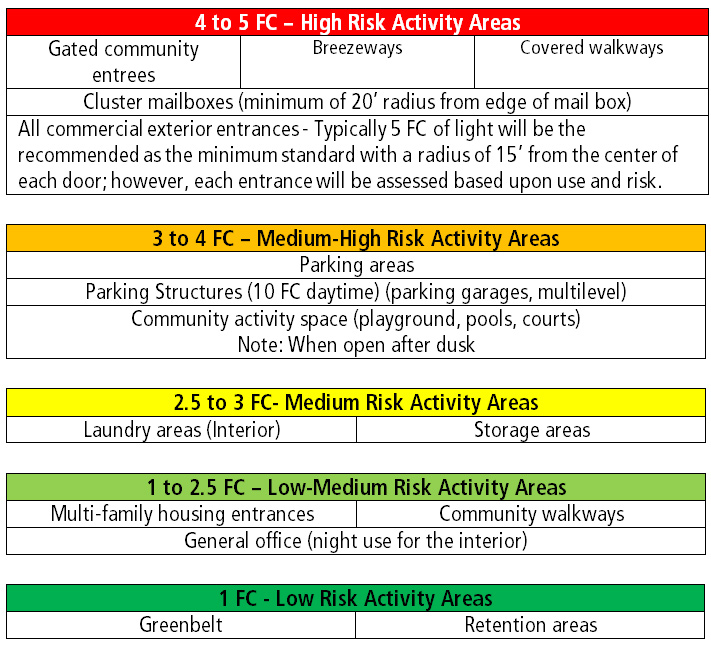
Although these guidelines are largely universal, many municipalities have lighting ordinances that may deviate from these guidelines and should be consulted as part of the assessment and design process.
Lighting Uniformity
Another important aspect of lighting is uniformity. Lighting uniformity affects our perception of the environment and our ability to safely navigate its features (e.g., walkways, stairs, etc.). Uniform lighting allows us to perceive the environment continuously and without sudden breaks caused by lighting level drops. Uniformity of lighting levels also impacts people’s perception of safety and security. Simply put, well-lit and uniformly illuminated areas make pedestrians feel more secure. A poorly lit parking lot, with severe variation (contrast) between peak and minimum illumination levels, feels darker, less secure, and may embolden criminal confidence.
To ensure uniformity, the type of light distribution pattern should be properly matched to the purpose. Following is a summary of light distribution patterns and recommended applications.
- Type I distribution is a two-way lateral distribution having a preferred lateral width of 15 degrees in the cone of maximum candlepower and is great for lighting walkways, paths, and sidewalks. This type of lighting is meant to be placed near the center of the pathway. This provides adequate lighting for smaller pathways.
- Type II light distributions have a preferred lateral width of 25 degrees and are used for wide walkways, on ramps and entrance roadways, as well as other long, narrow lighting. This type is meant for lighting larger areas and usually is located near the roadside. You’ll find this type of lighting mostly on smaller side streets or jogging paths.
- Type III light distributions have a preferred lateral width of 40 degrees. This type has a wider illumination area if you make a direct comparison to type II LED distribution, and is meant for general roadway lighting, parking areas and other areas where a larger area of lighting is required.
- Type IV distributions produce a semicircular light meant for mounting on the sides of buildings and walls. It’s best for illuminating the perimeter of parking areas and businesses. The intensity of the Type IV lighting has the same intensity at angles from 90 degrees to 270 degrees.
Modern LED light sources allow LED luminaires to more evenly dissipate light over large areas than HID (High-Intensity Discharge) light sources. Because LED lighting can more evenly illuminate an area, the space appears brighter and feels more secure. Replacing HID lighting with LED systems is a common recommendation in my reports. LED lighting also has excellent color rendition, meaning that light reflecting off the surface of objects displays the color more accurately. This makes it easier to accurately identify the color of a vehicle or the clothes an offender is wearing.
One of the most common issues I encounter during my assessments is insufficient illumination in places designated for human activity (e.g., sidewalks, playgrounds, parking lots, picnic areas, breezeways, mailboxes, residential building entrances, etc.). This is predominantly caused by the following issues:
- Existing lights obstructed by trees, shrubbery, dirt, or insects.
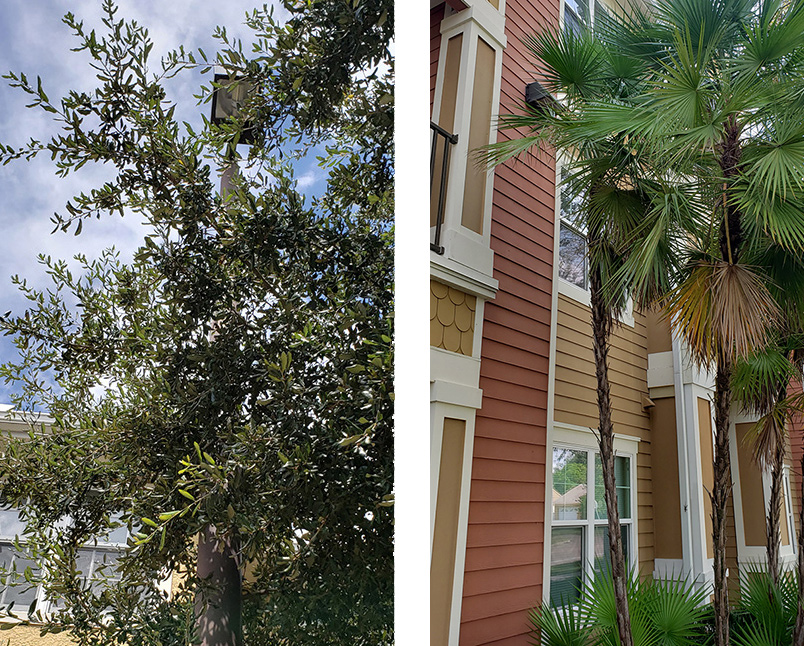
- Non-functional lights (e.g., burned-out light bulbs, damaged photocells, malfunctioning or incorrect ballasts, etc.)
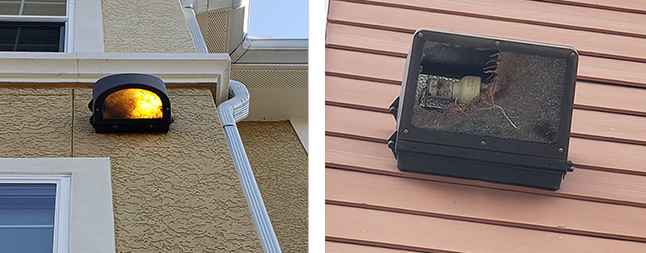
- Incorrect usage of light types. For example, converting to LED lighting without properly retrofitting the fixture.
- Insufficient illumination sources.
- Incorrect light distribution types.
- Light glare due to lack of shielding.

To assist clients in remedying lighting problems, we typically conclude our assessments by preparing a detailed lighting map identifying all luminaires on the property, the type of light fixtures in use, problematic lights, and metered illumination levels in locations so that problematic areas are clearly recognized. Specific recommendations for improvement are then submitted in the main body of the assessment report.
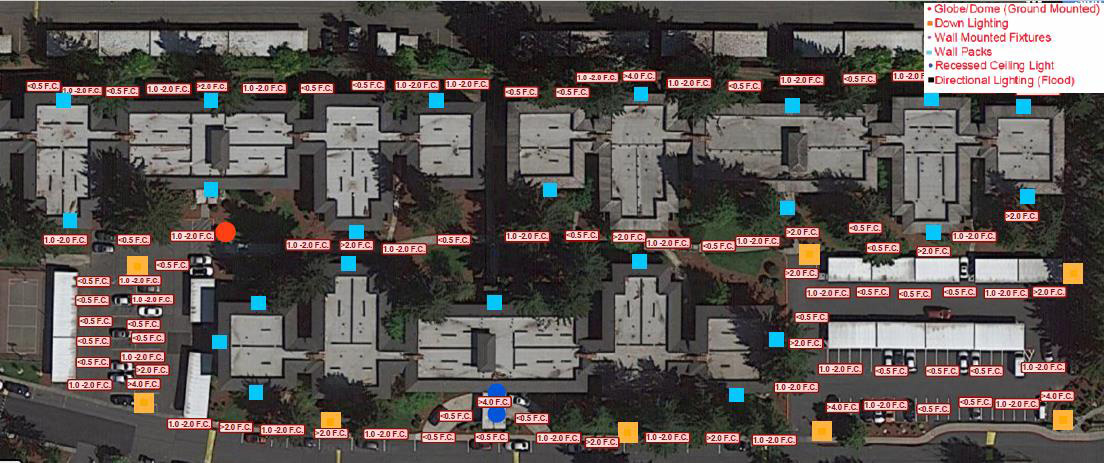
2. CCTV / Cameras
Poorly designed and/or maintained CCTV systems are another common problem in residential properties. Common issues include:
- Obstructed cameras
- Improper positioning of cameras
- Limited DVR storage
- Insufficient illumination to support effective use of cameras
- Malfunctioning or inoperative cameras
To address these problems, we recommend that property managers conduct a weekly camera inspection to ensure cameras are functioning properly and identify developing problems such as overgrown vegetation, etc. The inspection should ideally be conducted during nighttime since the cameras often appear to perform well during daytime, but may suffer under nighttime lighting conditions due to things like cobwebs, obstructions, and malfunctioning infrared illuminators.

We also commonly recommend using motion sensors for lights illuminating interior spaces under camera surveillance (e.g., clubhouses, fitness rooms, etc.). Lights activated by motion sensors can alert people when other individuals are present nearby, limit offender concealment, and provide indoor cameras with good illumination.
3. Landscaping
Landscaping design and maintenance also play an important role in crime prevention. As a symbolic barrier, landscaping can mark the transition between “zones,” define the property boundary, and discourage casual trespass. Landscaping can also serve as a barrier against committed intrusion when dense hedges or aggressive shrubbery are used.
When conducting assessments, I often encounter obstructed cameras and lights due to overgrown shrubbery, untrimmed trees, and other landscaping features. Overgrown shrubbery and untrimmed trees also provide an opportunity for offender concealment and embolden criminal confidence by restricting natural surveillance between residential units, parking lots and other areas designated for human activity. Overgrown shrubbery and untrimmed trees can result in liability issues.
A common recommendation in my reports is implementing a CPTED principle called the 2-feet/6-feet rule. Bushes and hedges are not to be taller than 2 feet, and tree canopies are not to be lower than 6-feet near areas designated for human activity. This approach ensures that visibility between three and six feet from the ground will always be relatively unimpaired.
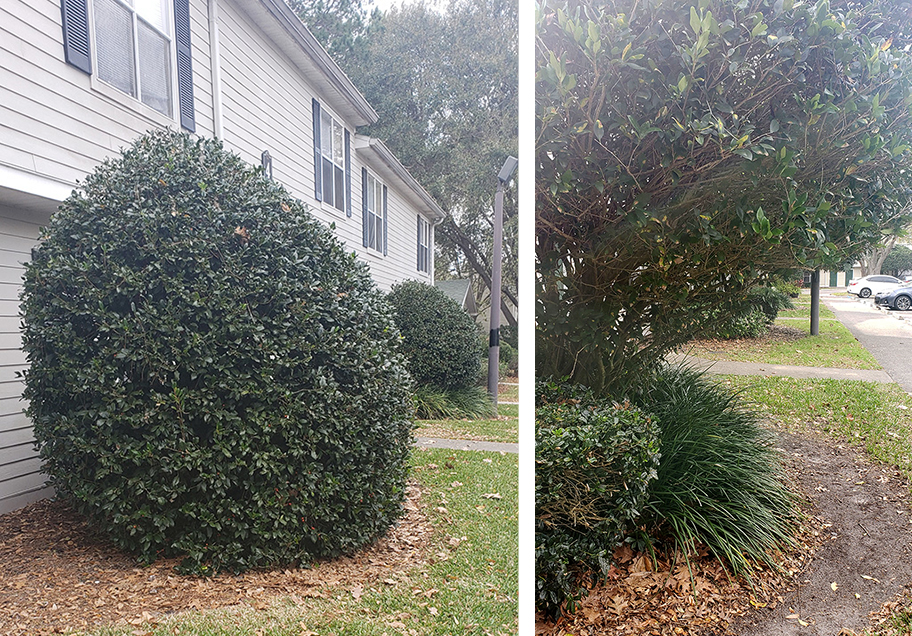
4. Documenting crime, community rule violations, and nuisance activities
Reducing social disorder and evicting problematic residents is another critical aspect of crime prevention in multi-family housing. This includes ensuring we have good documentation of crimes on a property, community rule violations, and nuisance activities in preparation for potential eviction. In many properties I assess, it is just a handful of bad apples amongst the resident population which are responsible for many crimes on property and community perceptions of fear. Left unaddressed, this situation can lead to higher resident turnover rates, lower occupancy rates, property damage, and liability issues.
Documenting on hardcopy solely can lead to loss of documentation in case of fire, flooding, etc. so it is important to store your documentation in your property management software for example.
5. Security officers
Security officers are the property manager’s eyes and ears when the property manager is not on site. And if used correctly, it can function as a deterrent to crime and improve resident perceptions of safety.
Unfortunately, very few properties I assess effectively use security officers. Sometimes this problem results from security officers with inadequate training and skills. At other times, the property manager fails to define the officers’ duties and expectations for performance.
When contracting a security company or a courtesy officer for the property, the expectations and duties of officers should be clearly established. These expectations should be ideally defined in a ‘scope of work’ to the contract, or in the form of post orders for the property.
Security officers assigned to patrol the property need to be aware of locations where criminal or nuisance activity is common, and any units or residents of concern. Proper documentation by security officers in the form of a daily activity report increases the property manager’s awareness of activities occurring when the property staff is absent. The property manager can correspondingly take action to make the property a safer place.

